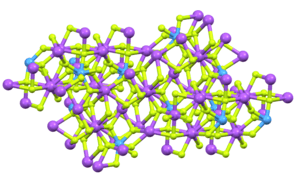Tantalum pentafluoride
Tantalum(V) fluoride is the inorganic compound with the formula TaF5. It is one of the principal molecular compounds of tantalum. Characteristic of some other pentafluorides, the compound is volatile but exists as an oligomer in the solid state.
_fluoride.png) | |
| Names | |
|---|---|
| Other names
tantalum pentafluoride | |
| Identifiers | |
3D model (JSmol) |
|
| ECHA InfoCard | 100.029.111 |
| EC Number |
|
PubChem CID |
|
| RTECS number |
|
| UNII | |
CompTox Dashboard (EPA) |
|
| |
| |
| Properties | |
| TaF5 | |
| Molar mass | 275.95 g/mol |
| Appearance | white powder |
| Density | 4.74 g/cm3, solid |
| Melting point | 96.8 °C (206.2 °F; 369.9 K) |
| Boiling point | 229.5 °C (445.1 °F; 502.6 K) |
| decomposes | |
| +795.0·10−6 cm3/mol | |
| Structure | |
| 0 D | |
| Hazards | |
| Main hazards | HF source |
EU classification (DSD) (outdated) |
not listed |
| R-phrases (outdated) | 34 |
| S-phrases (outdated) | 26-27-28-36/37/39-45 |
| Flash point | Non-flammable |
| Related compounds | |
Related compounds |
TaCl5 NbCl5 WF6 |
Except where otherwise noted, data are given for materials in their standard state (at 25 °C [77 °F], 100 kPa). | |
| Infobox references | |
Preparation and structure
It is prepared by treating tantalum metal with fluorine gas.[1] NbF5 is prepared similarly.
Solid and molten TaF5 is tetrameric, consisting of four TaF6 centers linked via bridging fluoride centers. Gaseous TaF5 adopts the trigonal pyramidal structure with D3h symmetry.[2]
Reactions and derivatives
The tendency of TaF5 to form clusters in the solid state indicates the Lewis acidity of the monomer. Indeed, TaF5 reacts with fluoride sources to give the ions [TaF
6]−
, [TaF
7]2−
, and [TaF
8]3−
. With neutral Lewis bases, such as diethyl ether TaF5 forms adducts.
TaF
5 is used in combination with HF as a catalyst for the alkylation of alkanes and alkenes and for the protonation of aromatic compounds. The TaF
5–HF system is stable in reducing environments, unlike SbF
5–HF.[3] In the presence of fluoride, tantalum pentafluoride forms the anions [TaF
8]3−
, [TaF
7]2−
, or [TaF
6]−
, depending on the nature of the counterion and the concentration of HF. High concentrations of HF favor the hexafluoride by virtue of the formation of HF−
2:[4]
- [TaF
7]2−
+ HF ⇌ [TaF
6]−
+ HF−
2
The salts M3TaF8 have been crystallized. For K+ = M+, the crystals consist of [TaF
7]2−
anions together with fluoride that does not coordinate to Ta(V).[5] For M+ = M+, the crystals features [TaF
8]3−
.[6]
 Section of the Na3TaF8 structure (Ta = turquoise, F = green).
Section of the Na3TaF8 structure (Ta = turquoise, F = green).
Relevance to separation of Ta and Nb
In the Marignac process, Nb and Ta are separated by fractional crystallization of K2TaF7 from solutions of hydrofluoric acid. Under these conditions, niobium forms K2NbOF5, which is more soluble than K2TaF7. Reduction of K2TaF7 with sodium gives metallic Ta.[7]
References
- Priest, H. F. (1950). "Anhydrous Metal Fluorides" Inorganic Syntheses". 3: 171-183. doi:10.1002/9780470132340.ch47. Cite journal requires
|journal=(help) - Holleman, A. F.; Wiberg, E. "Inorganic Chemistry" Academic Press: San Diego, 2001. ISBN 0-12-352651-5.
- Arpad Molnar; G. K. Surya Prakash; Jean Sommer (2009). Superacid Chemistry (2nd ed.). Wiley-Interscience. p. 60. ISBN 0-471-59668-X.
- Anatoly Agulyanski (2004). The chemistry of tantalum and niobium fluoride compounds. Amsterdam: Elsevier. p. 134. ISBN 0-444-51604-2.
- Ľubomír Smrčok, Radovan Černý, Miroslav Boča, Iveta Macková, Blanka Kubíková (2010). "K3TaF8 from Laboratory X-ray powder data". Acta Crystallographica C. 66: pi16–pi18. doi:10.1107/S0108270109055140.CS1 maint: uses authors parameter (link)
- Langer, V.; Smrčok, L.; Boča, M. (2010). "Redetermination of Na3TaF8". Acta Crystallographica C. 66: pi85–pi86. doi:10.1107/S0108270110030556.CS1 maint: uses authors parameter (link)
- Klaus Andersson, Karlheinz Reichert, Rüdiger Wolf "Tantalum and Tantalum Compounds" in Ullmann's Encyclopedia of Industrial Chemistry 2002, Wiley-VCH. Weinheim. doi:10.1002/14356007.a26_071